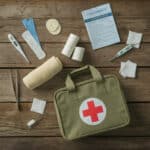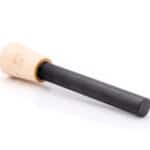Being prepared for emergencies is crucial, and having a well-stocked first aid kit is an essential part of that preparedness.
A first aid kit contains supplies to treat minor injuries and provide temporary care until professional medical help arrives. In this ultimate guide, we’ll cover what items to include, how to customize your kit, storage tips, the importance of first aid training, and provide handy checklists.
Table of Contents
Essential Supplies Every First Aid Kit Should Include
A basic first-aid kit should contain the following items:
- Adhesive bandages in various sizes to cover minor cuts and scrapes
- Sterile gauze pads and roller bandages to dress larger wounds
- Medical tape to secure dressings and splints
- Antiseptic wipes and antibiotic ointment to clean and prevent infection
- Scissors for cutting bandages and tape
- Tweezers for removing splinters and ticks
- Safety pins to fasten slings and bandages
- Instant cold compress to reduce swelling
- Non-latex gloves to prevent contamination
- First aid manual for reference
Each of these items plays a critical role. For example, antiseptic wipes clean wounds to prevent infections, while the cold compress reduces swelling and pain. Gloves protect both the caregiver and the patient. The first aid manual provides valuable instruction, especially in stressful situations.
Customizing Your Kit for Specific Needs
In addition to the basics, consider tailoring your first aid kit to your family’s needs:
- For babies and kids, include liquid bandage, antibiotic ointment, diaper rash cream, and children’s medications
- If family members have allergies, include an epinephrine auto-injector, antihistamines, and hydrocortisone cream
- For outdoor adventures, add moleskin for blisters, aloe vera for burns, and insect bite treatment
Choose a container that is durable, easy to carry, and keeps items organized and accessible. A tackle box or backpack with multiple compartments works well. For portable kits, use a waterproof pouch.
Maintaining and Storing Your First Aid Kit
First aid supplies don’t last forever. Check your kit regularly and replace any expired or damaged items. Keep your kit in a cool, dry place out of reach of children but easily accessible to adults. Have kits where you may need them – at home, in your car, at work.
Make sure your family knows where the kits are located and how to use the contents. Consider labeling items and including a content list in each kit.
First Aid Training and Emergency Preparedness
While having a first aid kit is important, knowing how to use it is essential. Consider getting certified in first aid and CPR. Many organizations, like the Red Cross, offer training courses.
In addition to your first aid kit, have a plan for emergencies. Know how to contact help, have backup power sources, stock extra food and water, and have an evacuation plan.
First Aid Kit Checklists for Different Situations
Here are some sample checklists for various first aid kits:
Camping and Outdoor Adventures
- Bandages, gauze, tape
- Antiseptic wipes, antibiotic ointment, alcohol wipes
- Moleskin and blister treatments
- Aloe vera gel and hydrocortisone cream
- Insect repellent and bite treatment
- Splints and elastic bandages for sprains
- Emergency blanket and rain poncho
- Prescription medications
- Sunscreen and lip balm
- Water purification tablets
- Matches in waterproof case
- Multi-tool with knife and scissors
Workplace and Job Sites
- Eyewash and eye pads
- Cold packs
- Burn dressings and gel
- Antiseptics and sanitizers
- Aspirin and ibuprofen
- Hydrocortisone cream
- Trauma shears and tweezers
- Finger splints
- CPR face shield
- Exam gloves
- First aid guide
Travel and Car Kits
- Adhesive bandages, gauze, tape
- Antiseptic wipes and triple antibiotic ointment
- Hydrocortisone cream and aloe vera
- Moleskin and blister pads
- Insect repellent and bite treatment
- Motion sickness and diarrhea medicine
- Pain and fever reducers
- Oral rehydration salts
- Instant cold pack
- Emergency mylar blanket
- Scissors, tweezers, safety pins
- Small flashlight with extra batteries
- First aid quick reference card
Print out these checklists and use them as a guide when assembling your first aid kits. Customize them based on your family’s specific needs and the situations you anticipate encountering.
Conclusion
A well-equipped first aid kit is a must-have for every home, vehicle, and workplace. By following this guide and using the checklists provided, you can ensure your kit is stocked with the essential supplies to handle common emergencies.
Remember, being prepared is key. In addition to having a kit, make sure you know how to use it and have a plan for emergencies. Consider getting first aid certified to gain valuable skills that could save a life.
Tip: Check out our Emergency Kit Supplies Checklist, which includes a free PDF Download.





















Leave a Reply